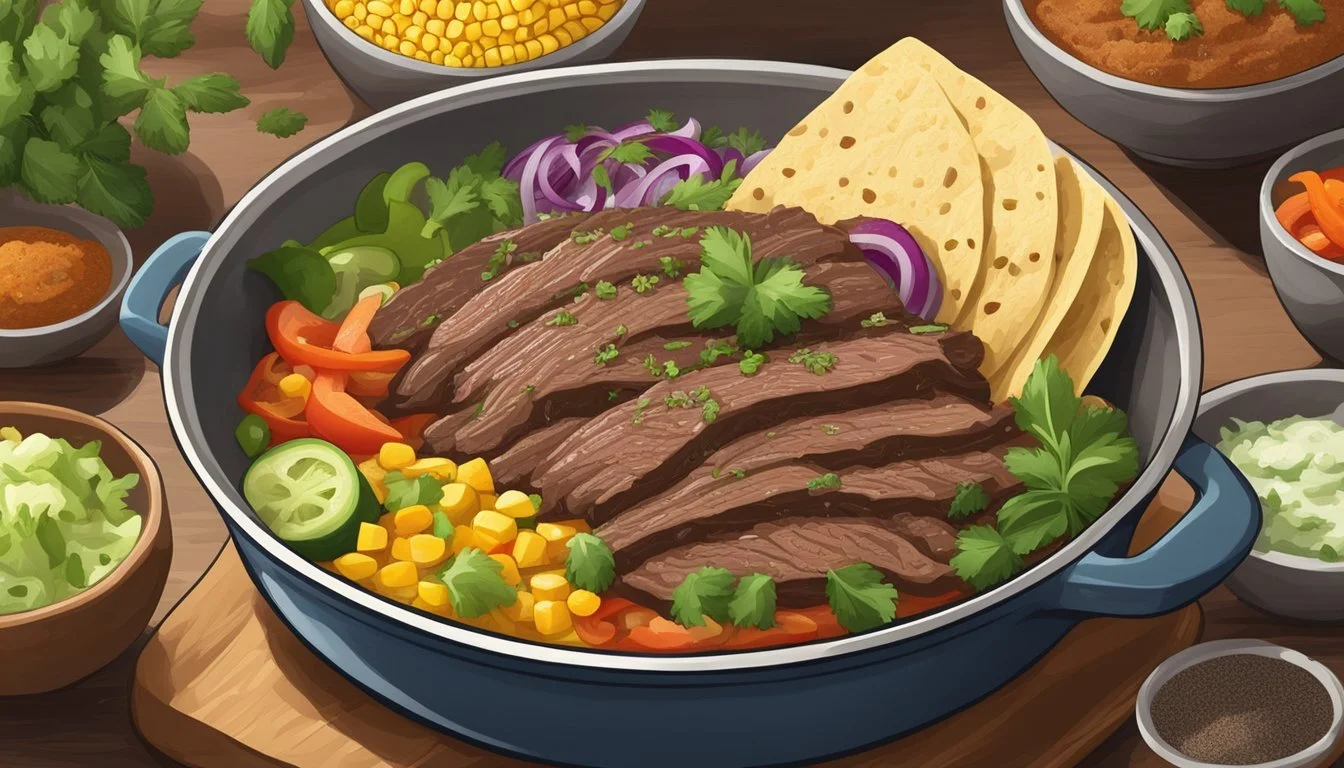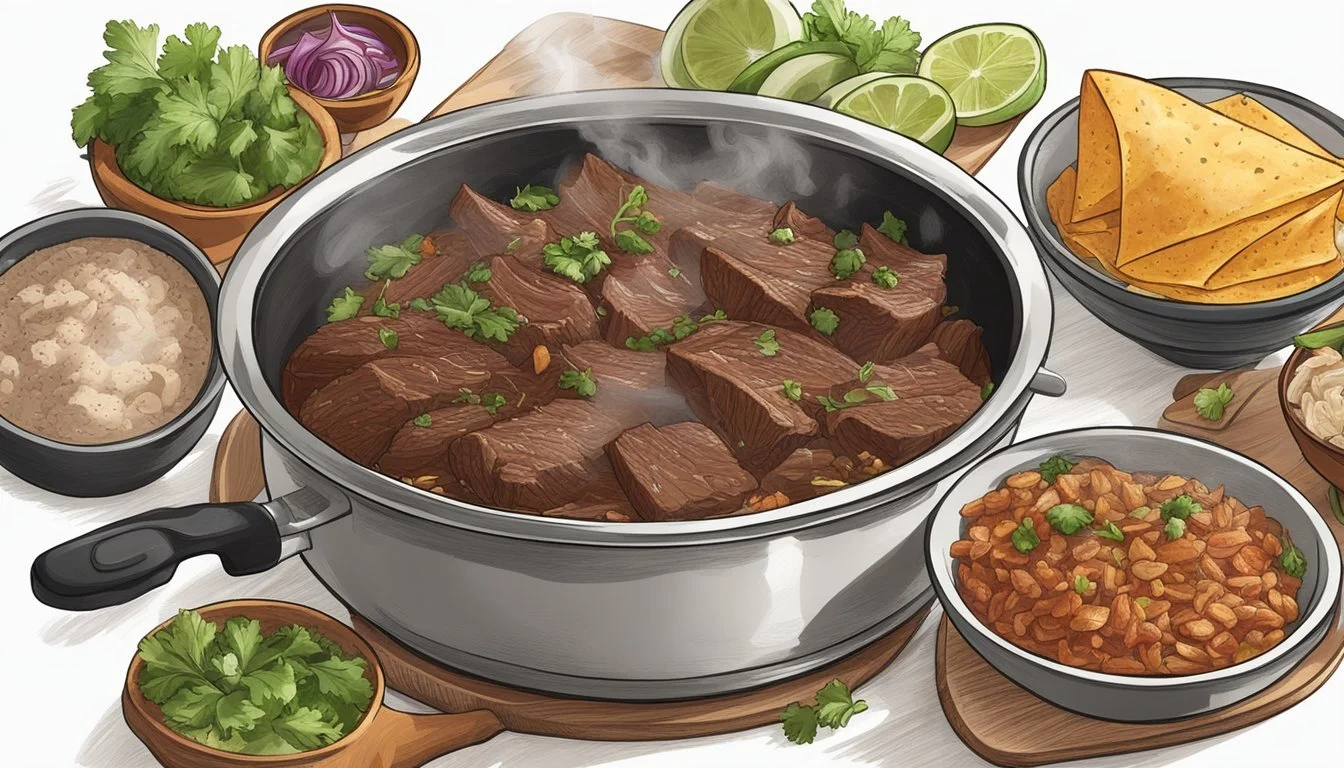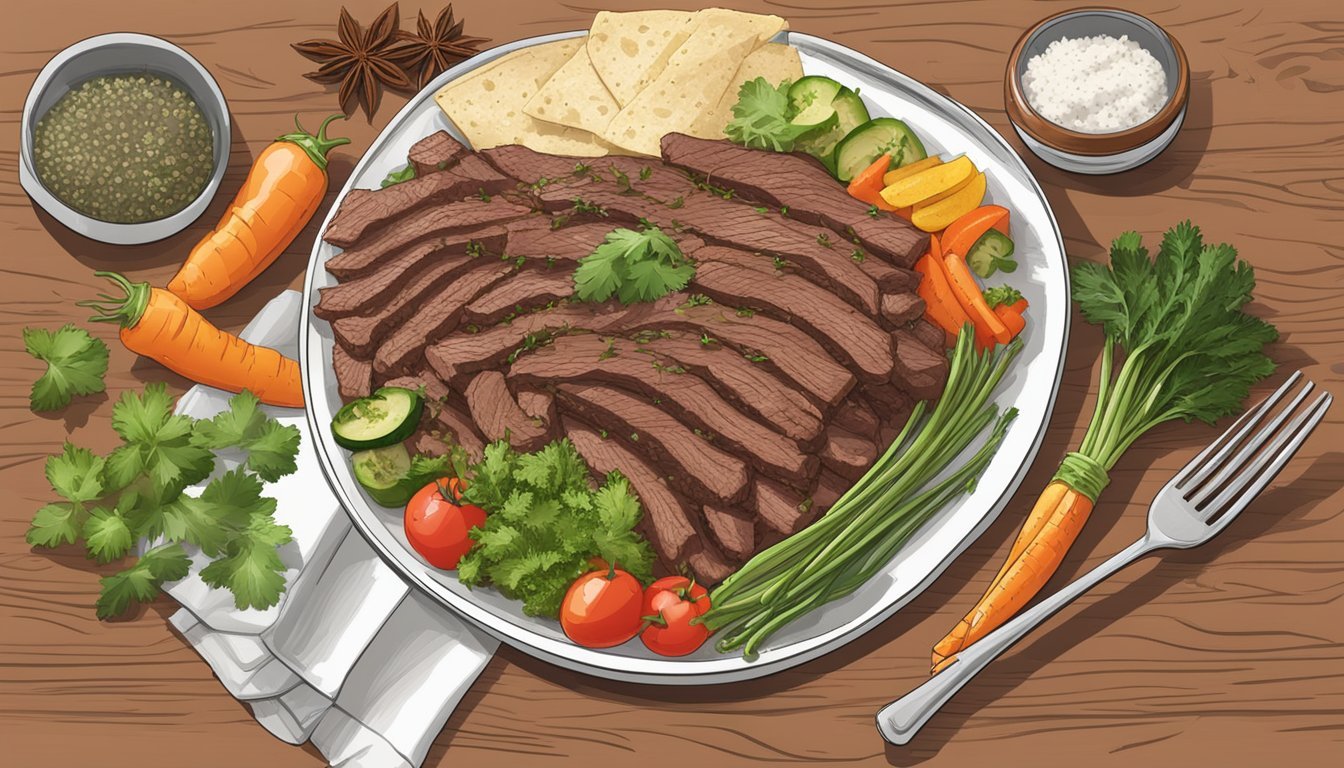Is Beef Barbacoa Gluten-Free?
Understanding Its Ingredients and Preparation
Beef (What wine goes well with beef?) barbacoa (What wine goes well with beef barbacoa?) is a flavorful dish that has its roots in traditional Mexican cuisine. It is often slow-cooked, which allows the robust spices and seasonings to fully permeate the beef, creating a tender and juicy meat that is easily shredded. The primary ingredients in beef barbacoa typically include beef brisket (What wine goes well with beef brisket?) or chuck roast, as well as various herbs and spices. Given the increased interest in gluten-free diets, many are curious whether this succulent dish meets the criteria to be considered gluten-free.
The essential components of beef barbacoa itself are naturally gluten-free. Beef, being a pure protein, does not contain gluten, and most of the traditional seasonings such as cumin, oregano, and garlic, are also free from gluten. However, gluten can be present in pre-packed spice blends or sauces that may be used in preparing barbacoa. For those with celiac disease or gluten sensitivity, the key to ensuring a gluten-free beef barbacoa lies in carefully selecting ingredients that have not been contaminated with gluten during processing.
When preparing beef barbacoa at home or selecting it from a menu, it is important to consider every ingredient used in its preparation. For a completely gluten-free dish, any sauces or marinades should be verified as gluten-free, and the cooking process should avoid cross-contamination with gluten-containing foods. As such, for those on a gluten-free diet, beef barbacoa can remain on the menu with a mindful approach to its preparation and the choice of ingredients.
Understanding Beef Barbacoa
Beef barbacoa is a traditional dish with deep roots in Mexican cuisine, typically cooked with a specific set of ingredients and methods. This section provides insights into the traditional origins, preparation methods, and common ingredients of beef barbacoa.
Traditional Barbacoa Origins
Originating from Mexico, barbacoa is a method of cooking that initially involved steaming meat over an open fire or in a hole dug in the ground. This ancient technique has evolved, but still retains the essence of its rich culinary heritage. Traditional barbacoa was often made with lamb or goat, but beef has become equally popular in various adaptations of the recipe.
Barbacoa Beef Preparation Methods
Barbacoa beef can be prepared in several ways, including in a slow cooker, oven, or smoker. The slow cooker or crockpot method is particularly popular for its convenience and the ability to tenderize the meat over several hours. When using an oven, a Dutch oven is typically employed to maintain moisture during a prolonged cooking period at low temperatures. The smoking method, less common at home, imparts a distinct smoky flavor reminiscent of the traditional pit-smoking technique.
Common Ingredients in Beef Barbacoa
The common ingredients in a beef barbacoa recipe include:
Meat: Beef chuck roast or brisket are preferred for their marbling and flavor.
Spices: A blend of spices such as cumin, oregano, and chili powder is essential for authentic taste.
Acid: Lime juice or vinegar adds a tangy flavor profile and helps tenderize the meat.
Heat: Chili peppers, adobo sauce, or chipotle powder contribute to the dish's spiciness.
Aromatics: Garlic and onions are foundational for building depth of flavor.
Herbs: Bay leaves are often included in the cooking process and removed before serving.
Careful blending of these elements results in the robust and savory flavor that characterizes beef barbacoa.
Gluten-Free Cooking Considerations
When preparing gluten-free beef barbacoa, it is crucial to identify potential sources of gluten and utilize safe, gluten-free ingredients. Careful selection and handling can ensure a delicious meal free from gluten contamination.
Identifying Gluten Sources
Key Gluten-Containing Grains: Gluten is a protein found in certain grains such as wheat, barley, and rye. These are commonly used in various food products and must be avoided to ensure a gluten-free meal.
Common Gluten Sources: Ingredients such as flour tortillas, some adobo sauces, and seasonings may contain gluten. One must read labels carefully, as gluten can be present under names like malt, starches, hydrolyzed proteins, and certain food additives.
Cross-Contamination: A significant consideration is cross-contamination, which can occur if gluten-free foods come into contact with gluten-containing foods. Utensils, cutting boards, and cookware must be used exclusively for gluten-free cooking or thoroughly cleaned if used with gluten-containing foods.
Safe Ingredients for Gluten-Free Cooking
Gluten-Free Alternatives: When cooking beef barbacoa, certain ingredients must be selected to maintain a gluten-free status.
Tortillas: Use corn tortillas instead of flour tortillas.
Grains: Substitute wheat with gluten-free grains like rice or quinoa. Cauliflower rice is a low-carb, gluten-free alternative that can supplement or replace traditional rice.
Thickeners: Instead of wheat flour, opt for cornstarch or potato starch for thickening sauces.
Gluten-Free Adobo Sauce: Adobo sauce often contains gluten. One must find a gluten-free labeled version or make a homemade sauce with certified gluten-free ingredients.
Safe Gluten-Free Ingredients To Avoid Cornstarch for thickening Wheat-based flour Corn tortillas Flour tortillas Gluten-free adobo sauce Non-labeled adobo sauces Cauliflower rice Barley or rye-based sides
By incorporating gluten-free alternatives and vigilantly avoiding cross-contamination, one can confidently prepare beef barbacoa that is safe and enjoyable for those adhering to a gluten-free diet.
Making Gluten-Free Beef Barbacoa
When crafting gluten-free beef barbacoa, one must scrutinize ingredients for hidden gluten and select a suitable cooking method to ensure both safety and flavor.
Selecting Gluten-Free Ingredients
The first critical step in making beef barbacoa gluten-free is to carefully choose ingredients that do not contain gluten.
Meat: Start with high-quality beef brisket or chuck roast, ensuring it is fresh and unprocessed.
Seasonings: Opt for pure spices such as cumin, oregano, salt, and ground cloves. Verify that they are not processed or blended with gluten-containing additives.
Sauce Ingredients: Utilize gluten-free beef broth, fresh garlic cloves, and apple cider vinegar. For added flavor, include chipotle peppers in adobo sauce only if the label confirms it's gluten-free.
Thickeners: Avoid sauces and thickeners that may contain gluten; when in doubt, read labels or make components from scratch.
Produce a flavorful marinade by blending the sauce ingredients until smooth, being careful that each element is confirmed gluten-free.
Choosing the Right Cooking Method
Selecting an appropriate cooking method is essential to achieve a tender and flavorful beef barbacoa.
Slow Cooker: A slow cooker is ideal for producing tender and juicy barbacoa. Combine the meat with the gluten-free sauce mixture, set it to cook on low for 8 to 9 hours, or on high for 6 hours.
Crock Pot Instructions: Place the seasoned beef into the pot, cover with the sauce, and add bay leaves. After cooking, remove the bay leaves and shred the meat with two forks before allowing it to absorb the juices.
Instant Pot: For a faster option, an Instant Pot can reduce cooking time while still infusing the beef with the rich flavors of the marinade. Consult your device's manual for specific cooking times and settings.
Instant Pot Tips: Ensure that the sealing ring is correctly placed and that the valve is set to sealing to avoid steam escaping during the high-pressure cooking process.
In both methods, the resulting dish should be monitored for consistency, and seasonings adjusted as needed before serving.
Serving and Accompaniments
When serving beef barbacoa, it's important to offer a variety of gluten-free sides and toppings that complement the rich and savory flavors of the dish. Careful selection of accompaniments can enhance the barbacoa experience while adhering to dietary needs.
Suitable Sides and Toppings
Beef barbacoa's bold flavors pair well with a range of gluten-free sides and toppings. Traditional corn tortillas present an excellent alternative to flour tortillas, catering to those who avoid gluten. For a refreshing crunch, lettuce is a viable wrap option and aligns with keto preferences.
Rice: A classic choice is cilantro lime rice, or for a low-carb option, cauliflower rice.
Beans: Both pinto and black beans complement the barbacoa without gluten concerns.
Toppings: Fresh toppings like diced avocado, guacamole, salsa, and chopped cilantro add vibrant flavors and textures.
These sides and toppings not only amplify the taste but also ensure that the meal satisfies different dietary preferences, including those who follow a gluten-free diet.
Serving Suggestions for Barbacoa
Offering beef barbacoa in various serving styles allows guests to enjoy this versatile dish in a manner that suits their tastes and dietary needs.
Tacos/Burritos/Quesadillas: Use gluten-free corn tortillas for tacos, burritos, or quesadillas to keep the meal celiac-friendly.
Burrito Bowls/Nachos: Assemble burrito bowls with a base of rice and beans, topped with barbacoa and chosen toppings. For nachos, select gluten-free chips as the base.
Enchiladas: Create enchiladas with corn tortillas, ensuring all sauces and seasonings are verified gluten-free.
These suggestions provide a framework for diners to engage with barbacoa in a way that respects gluten-free limitations while still enjoying a rich culinary tradition.
Recipe Variations and Tips
When preparing beef barbacoa, there are various ways to tailor the recipe to specific dietary needs or to enhance the flavor profile. One can adjust the seasoning to fit dietary restrictions or add certain ingredients to elevate the dish's taste.
Adjustment for Dietary Restrictions
Gluten-Free: Traditional beef barbacoa recipes can be modified to be gluten-free by ensuring all the ingredients, including the chipotle peppers in adobo sauce, are certified gluten-free. It's important to check spice mixes for any hidden gluten-containing additives.
Keto and Paleo: To make beef barbacoa keto-friendly or suitable for a paleo diet, one should eliminate any sugars and use a low-carb beer or substitute the beer with beef broth. Additionally, serving the barbacoa with lettuce wraps instead of tortillas can cater to these dietary restrictions.
Flavor Enhancements
Citrus Twist: Incorporating fresh lime and orange juice can add a bright, citrusy note to the beef barbacoa, tenderizing the meat and infusing it with flavor.
Herbaceous Touch: Fresh cilantro can be mixed into the beef once it is shredded to provide a herbaceous and fresh flavor, complementing the richness of the meat.
Spices: Using a combination of chipotle peppers, adobo sauce, and spices such as cumin and black pepper can intensify the smoky and savory elements of the beef barbacoa.
Nutrition and Health Aspects
When considering beef barbacoa, it's important to look at its nutritional profile, which includes a significant amount of protein and generally low calorie count. As a gluten-free option, it is suitable for those with celiac disease or gluten sensitivity.
Protein and Caloric Content
Beef barbacoa is rich in protein, making it a substantial option for individuals who are looking to sustain or build muscle mass. Typically, 4 ounces of barbacoa beef can deliver about 13 grams of protein with a caloric content of approximately 110 calories. This makes it a nutrient-dense food choice that provides essential amino acids without an excessive calorie load.
Protein Content: About 13g per 4 ounces
Caloric Content: Approximately 110 calories per 4 ounces
Benefits of Gluten-Free Barbacoa for Health
For those who suffer from celiac disease or have a gluten allergy, consuming gluten-free foods is crucial for health. Barbacoa, traditionally a slow-cooked dish, is naturally gluten-free when no gluten-containing ingredients are used in its preparation. This aspect of barbacoa allows individuals with dietary restrictions to enjoy a flavorful and tender meat option without the repercussions that gluten can cause in sensitive individuals.
Suitable for gluten intolerance: Naturally free from gluten, safe for celiac disease sufferers.
Avoids allergy triggers: Does not contain gluten which is a common allergen.
Online Presence and Promotion
With the rising popularity of gluten-free diets, businesses are taking advantage of online platforms to promote their gluten-free beef barbacoa. These strategies focus mainly on leveraging social media reach and actively engaging with audiences to increase product visibility and appeal.
Marketing Through Social Media
Companies utilize social media platforms like Instagram to market their gluten-free beef barbacoa. They craft visually appealing posts of the dish, often using popular hashtags to improve discoverability. By including affiliate links in their profiles or post descriptions, they provide easy access for potential customers to purchase products or learn more. Posts with high numbers of likes, comments, and shares typically indicate better engagement and a wider organic reach.
Engaging the Audience
To further their reach, companies often encourage audience engagement by prompting customers to tag their own experiences with the gluten-free beef barbacoa. This personal element not only increases the product's visibility but also creates a community around the brand. Companies may respond to comments or feature user-generated content on their pages to foster a participatory culture, which in turn can boost user interaction and attract new customers.







